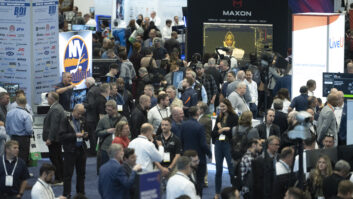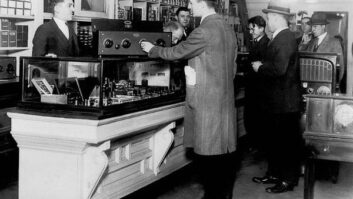Yamaha has an impressive history providing digital mixing to the masses.

The Yamaha 01V96i sits in the studio next to our Wheatstone D-75 console.
Starting in 1987 with the DMP7, on to the ProMix01 and 02R, followed by the introduction of the 03D and the 01V in 1998, Yamaha is clearly no newcomer to digital mixing technology. The 01V found homes in many small production and bedroom studios.he 01V96 was a complete redesign, offering not just increased sample rates, but greater flexibility and a more professional feel.
Yamaha now introduces the 01V96i. Side by side, the two look almost identical. The control surface remains unchanged, aside from differently colored knobs and a slightly darker paint scheme. Rear-panel connections are also unchanged from the earlier version. The real changes happen “under the hood,” the biggest being in the USB port.
On the original 01V96, the USB port was used to allow mixer communication with a host PC to manage the mixer’s automation scenes. Now, in addition to that, the 01V96i USB port allows up to 16 channels of digital audio to pass directly between the mixer and the host PC or Mac and interface with many popular DAW applications. In other words, the mixer is also a 16 x16 sound card.
The 01V96i also boasts improved input preamps, with a dynamic range of 110 dB. It retains the Virtual Circuit Modeling technology of the 01V96VCM, with its ability to model the sounds of well-known analog signal processors, including Yamaha’s own venerable SPX series. Anyone accustomed to previous incarnations of the 01V96 will feel right at home. The various screens and menus are unchanged, save for the addition of available USB inputs and outputs.
Layers
For the uninitiated, the 01V96i is a 32-channel, eight-bus recording console, featuring eight auxiliary sends, EQ, compression and gating on every channel, and built-in effects such as reverb and delay. A comparable analog console would be the size of a dining room table, yet the 01V96i takes up no more space than a computer. How? Everything between the 18 analog inputs (12 mono mic/line inputs, two stereo line inputs, stereo “tape” return) and eight analog outputs (stereo out, four “omni” outs, stereo ”tape” out) is completely digital. All 32 channels, aux masters, and eight buses, as well as the main stereo outputs, are represented by just 17 100 mm faders. The function of these faders is determined by what “layer” is selected. Think of it as taking a larger console, slicing it three ways, and stacking those slices on top of each other.

Space is also saved by consolidating common controls into just one set of knobs and buttons, assigned based on which channel or display screen is selected. The display gives access to scene libraries, I/O setups, routing controls, dynamics and EQ controls and other options. While the numerous screens and available options may seem overwhelming at first, a quick read of the abridged owner’s manual provides enough information to get started. This hard copy manual is supplemented by a CD-based reference manual that goes into greater detail. Where I found the documentation to be lacking was in covering the mixer’s ASIO driver for the USB I/O. The instructions for the driver are included in the driver ZIP file available from www.yamahaproaudio.com. I would have preferred this information be included in the owner’s manual, since that’s the first place a new user is likely going to look.
Included is a DVD copy of Steinberg’s Cubase AI 6, providing “out-of-the-box” functionality. Additional software includes Yamaha’s Studio Manager and 01V96i Editor. The former allows PC or Mac control of various pieces of Yamaha hardware, while the latter works in conjunction with Studio Manager to provide a computer-based control interface. The Editor presents a “virtual” version of the mixer on-screen. With a few clicks of a mouse, mixer configurations can be created and saved. This is especially useful if a user prefers not to operate the mixer via its own LCD screen. Up to 99 scenes can be saved in the mixer. If a setting for a particular venue or production is used regularly, the user can save it for later recall. With the push of a button all settings, from EQ to effects to output level are instantly recalled. The only settings that cannot be automated are the analog preamp gains.
Using the pan/routing and patch views, it’s possible to assign any input to any number of outputs. Signal sources can be hard-wired to the analog or digital inputs and then assigned channel inputs, aux inputs, effect inputs, etc. with a push of a button.
Let’s say a mic processor is connected to Channel 2. If I wanted that source to come up on Channel 11, it’s just a matter of selecting that route. Even the hardware insert points on Channels 1–12 can be patched pre- or post-EQ or even post-fader. All patch setups can be saved in their own separate library for later recall.
Extras
PRODUCT CAPSULE
Yamaha 01V96i Digital Mixer
Thumbs Up
+ Extremely flexible
+ Good sound quality
+ Multichannel I/O
Thumbs Down
– Included documentation needs improvement
Price: $2,699
For information, contact Yamaha in California at (714) 522-9011 or visit www.yamaha.com/proaudio.
Other useful features include a built-in tone generator that can be routed to any bus, aux send or stereo output; four “omni” outputs on the back panel that can be fed by aux sends for mix-minus or headphone feeds, insert points, or even a surround matrix; plus the ability to lock the controls with a password. This is especially handy if the mixer is used in a radio production room that is shared. There are also eight user defined keys — buttons that can be configured as shortcuts for many different functions.
The 01V96i also has the ability, via MIDI or USB, to act as a control surface for several popular DAW programs, including Pro Tools, Nuendo and Cubase. There is also an eight-channel ADAT I/O on the rear panel, as well as S/PDIF and word clock. The expansion slot on the rear can accept several I/O cards, available from Yamaha, for even more options, including additional analog and AES/EBU I/O.
As mentioned earlier, the other improvement is in the mic preamps. I compared them to the preamps in the original 01V96, using dynamic, condenser and ribbon microphones. My sources were male and female voices and acoustic guitar. For starters, the 01V96i’s preamps definitely have more gain, especially handy when dealing with ribbon mics. My ribbon also sounded punchier than on the older preamps, particularly on male voice, which can sometimes suffer from a ribbon’s darker tone. A dynamic mic seemed to have more bottom, but without sounding muddy. The condenser mic benefited most from the upgrade, needing less gain and sounding much brighter without sounding harsh.
Overall, I found the 01V96i enjoyable to use. Granted, my experience with its predecessor, limited as it is, gave me a leg up on the learning curve. It’s solidly built and sounds good. As I mentioned, I thought the documentation could have been a little better, but it by no means left me in the dark. If you already own an 01V96, is it worth replacing with the 01V96i? Chances are you’ve already got a viable I/O solution between the mixer and the DAW, so that will certainly affect your decision. (If it ain’t broke …) On the other hand, if you’re looking to get into a hardware-based digital recording and mixing solution for a production studio or road rig, the 01V96i fills the bill as an all-in-one solution.
Curt Yengst, CSRE, is assistant engineer at WAWZ(FM) in Zarephath, N.J.












